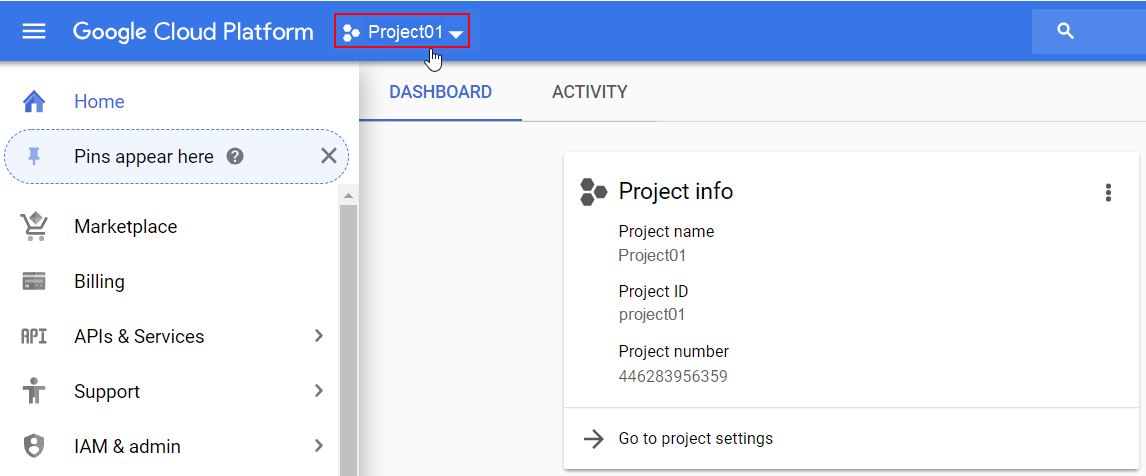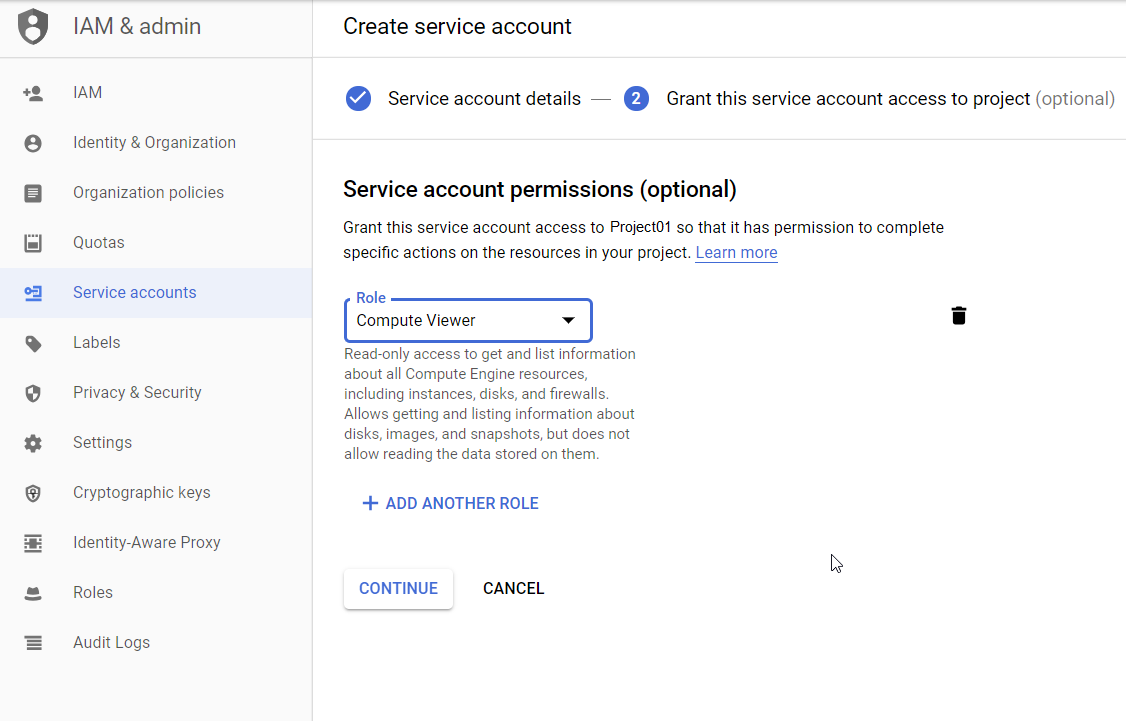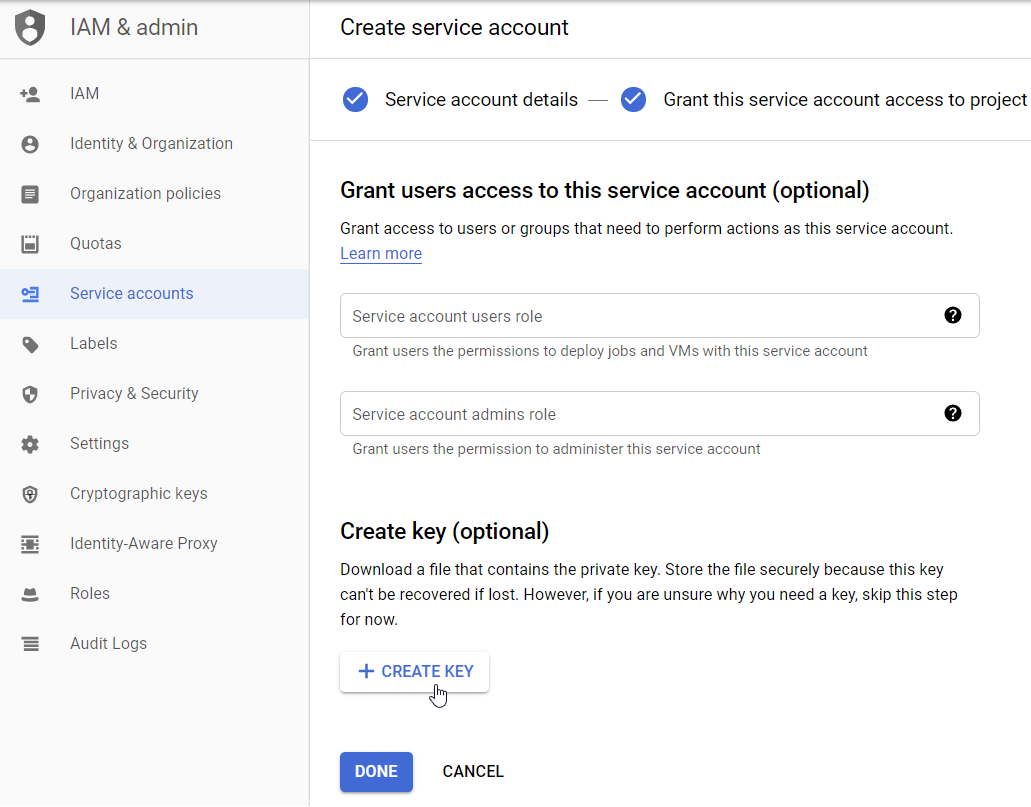Below is all the information you need to create a Google Cloud Platform (GCP) service
account for
use with Server & Workload Protection.
TipFor information on why you might want to create a GCP service account to use with
Server & Workload Protection, see What are
the benefits of adding a GCP account?
|
Prerequisite: Enable the Google APIs
Before you can create a GCP service account for Server & Workload Protection,
you'll need to enable a few Google APIs under your existing GCP account.
Follow the procedure below to enable these APIs inside each of your projects:
Procedure
- Log in to Google Cloud Platform using your existing GCP account. This account must have access to all the GCP projects that contain VMs that you want to protect with Server & Workload Protection.
- At the top, select a project that includes VMs that you want to add to Server & Workload Protection. If you have multiple projects,
you can select them later. For example:
Project01
- Click Google Cloud Platform at the top to make sure you're on the Home screen.
- From the tree view on the left, select .
- Click + ENABLE APIS AND SERVICES.
- In the search box, enter cloud resource manager API and then click the Cloud Resource Manager API box.
- Click ENABLE.
- Repeat steps 5 - 7 of this procedure, entering compute engine API and clicking the Compute Engine API box.
- Repeat steps 1 - 9 of this procedure for any other projects that include VMs that you want to add to Server & Workload Protection.
What to do next
For more information on how to enable or disable APIs in GCP, refer to this page from
Google:
Create a GCP service account
NoteA service account is a special type of Google account that is associated with an application
or
VM, instead of an individual end user. Server & Workload Protection assumes the identity of the
service account to call Google APIs, so that users aren't directly involved.
|
Follow the procedure below to create a service account for Server & Workload Protection:
Procedure
- Before you begin, make sure you've enabled the GCP APIs. See Prerequisite: Enable the Google APIs.
- Log in to Google Cloud Platform using your existing GCP account.
- At the top, select a project. If you have multiple projects, you can select any one.
For example:
Project01. - Click Google Cloud Platform at the top to make sure you're on the Home screen.
- From the tree view on the left, select .
- Click + CREATE SERVICE ACCOUNT.

- Enter a service account name, ID and description.
For example:

- Service account name:
GCP Server & Workload Protection - Service account ID:
gcp-deep-security@<your_project_ID>.iam.gserviceaccount.com - Service account description:
GCP service account for connecting Server & Workload Protection to GCP.
- Service account name:
- Click Create.
- In the Select a role drop-down list, select the role, or click inside the Type to filter area and enter compute viewer to find it.
- Click CONTINUE.
You have now assigned the Compute Viewer role.

- Click + CREATE KEY.

- Select JSON and click CREATE.
 The key is generated and placed in a JSON file.
The key is generated and placed in a JSON file. - Save the key (JSON file) to a safe place.
- Place the JSON file in a location that is accessible for later upload. If you need
to move or distribute the file, make sure you do so using secure methods.
- Click DONE.
You have now created a GCP service account with necessary roles, as well as a service
account key in JSON format. The service account is created under the selected project
(Project01), but can be associated with additional projects. For details, see the
following section.

Note
It will take 60 seconds - 7 minutes for the IAM permissions to propagate through the system. See this Google article for details.
Add more projects to the GCP service account
If you have multiple projects in GCP, you must associate them with the service account
you just
created. All your projects (and underlying VMs) will then become visible in the
Server & Workload Protection console when you later add the
service account to Server & Workload Protection.
NoteIf you have many projects, you might find it easier to divide them up across multiple
GCP
accounts instead of adding them all to just 1, as described below. For
details on a multi-GCP account setup, see Create
multiple GCP service accounts.
|
Follow this procedure to associate additional projects with 1 service account:
Procedure
- Before you begin, make sure you have completed the procedures in Prerequisite: Enable the Google APIs and Create a GCP service account.
- Determine the email of the GCP service account you just created, as follows:
- In Google Cloud Platform, from the drop-down list at the top, select the project under which you created the GCP service account (in our example, Project01).
- On the left, expand .
- In the main pane, look under the Email column to find the GCP service account email. For example: gcp-deep-security@project01.iam.gserviceaccount.com The service account email includes the name of the project under which it was created.
- Note this address or copy it to the clipboard.
- Still in Google Cloud Platform, go to another project by selecting it from the
drop-down list at the top. For example:
Project02.
- Click Google Cloud Platform at the top to make sure you're on the Home screen.
- From the tree view on the left, click .
- Click ADD at the top of the main pane.
- In the New members field, paste the Project01 GCP service account email address. For example:
gcp-deep-security@project01.iam.gserviceaccount.com
Tip
You can also start typing the email address to auto-fill the field. - In the Select a role drop-down list, select the role, or click inside the Type to filter area
and enter
compute viewerto find it. You have now added the service account with the Compute Viewer role to
You have now added the service account with the Compute Viewer role toProject02. - Click SAVE.
- Repeat steps 1 to 9 in this procedure for each project that you want to associate
with the GCP service account.
What to do next
For more information on how to create a service account, refer to the following page
from Google:https://cloud.google.com/compute/docs/access/create-enable-service-accounts-for-instances
You are now ready to add the GCP account you just created to Server & Workload Protection. Proceed to Add a Google Cloud
Platform account.
Create multiple GCP service accounts
Normally, you would Create a single GCP service account for Server & Workload Protection and associate all your projects to
it. This configuration is straightforward and works well for smaller
organizations with fewer projects. If, however, you have a large number of
projects, having them all under the same GCP service account might make them
difficult to manage. In this scenario, you can divide your projects across
multiple GCP service accounts. Here's how you would set this up, assuming your
projects were spread across your organization's Finance and Marketing
departments:
Procedure
- Create a
Finance GCP Server & Workload ProtectionGCP service account for Server & Workload Protection. - Add finance-related projects to
Finance GCP Server & Workload Protection. - Create a
Marketing GCP Server & Workload ProtectionGCP service account for Server & Workload Protection. - Add marketing-related projects to
Marketing GCP Server & Workload Protection. For detailed instructions, see Create a Google Cloud Platform service account and Add more projects to the service account. - After creating the GCP service accounts, add them to Server & Workload Protection one by one, following the instructions Add a Google Cloud Platform account.

